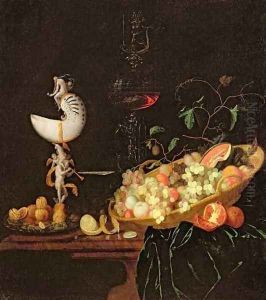Georg Hinz Paintings
Georg Hinz was a German Baroque painter, born in Hamburg in 1630. He is best known for his still life paintings, which often featured the vanitas theme, a common motif in Baroque art that symbolizes the transience of life, the futility of pleasure, and the certainty of death, encouraging a somber worldview.
Hinz's early life and training are not well-documented, but it is believed that he may have traveled to the Netherlands, which was a center for still life painting during that period, to study the works of Dutch masters. This influence is evident in his meticulous attention to detail and the use of light and shadow to create depth and realism in his paintings.
His works typically depicted the traditional elements of vanitas still lifes, such as skulls, candles, books, musical instruments, and other objects that symbolize human achievements and pleasures, juxtaposed with symbols of death and decay. Through these compositions, Hinz conveyed moral messages about the ephemerality of earthly pursuits and the importance of leading a virtuous life.
Hinz spent most of his career in Hamburg, where he became a respected member of the art community. He was active during a time when the city was experiencing economic prosperity, which allowed for a flourishing of the arts. Patrons from the growing middle class and merchant elite often commissioned works from artists like Hinz, seeking both decoration for their homes and reminders of the moral values of the time.
Georg Hinz died in 1688 in Hamburg. Although not as widely known today as some of his contemporaries, his work represents an important contribution to the Baroque period, particularly in the genre of still life painting. His paintings can be found in various art collections and museums, offering insight into the cultural and artistic sensibilities of 17th century Germany.
